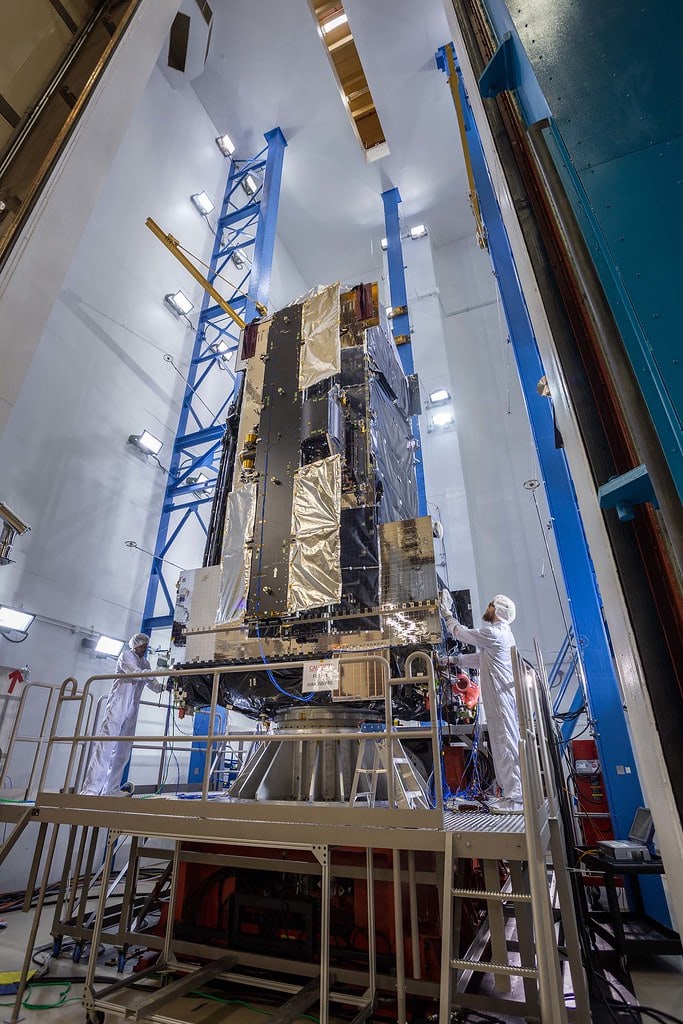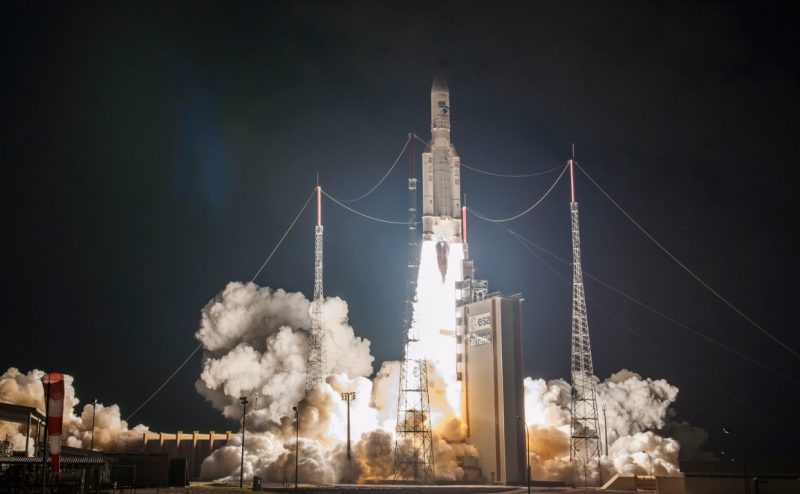Lift Off Window
|
February 18, 2020 – 22:18:00 – 23:20 UTC | 17:18 – 18:20 EST |
|---|---|
Mission Name and what it is |
|
Launch Provider
|
Arianespace |
Customer
|
|
Rocket |
Ariane 5 ECA |
Launch Location |
Launch Area 3, Guiana Space Center, Kourou, French Guiana |
Payload mass |
9,236 kg (about 20,361 pounds) |
Where are the satellites going? |
Geostationary Transfer Orbit (Initially 35,786 km x 250 km, with 6° inclination) |
Will they be attempting to recover the first stage? |
No this is not a capability of Arianespace |
Where will the first stage land? |
It will crash into the ocean |
Will they be attempting to recover the fairings? |
No this is not a capability of Arianespace |
Are these fairings new? |
Yes |
This will be the: |
|
Where to watch |
Official Livestream |

What’s all this mean?
Arianespace’s Ariane 5 ECA rocket is launching two satellites – GEO-KOMPSAT-2B for the Korea Aerospace Research Institute (KARI) and JCSAT-17 SKY Perfect JSAT Corporation. Subsequently, after a successful deployment, both satellites will eventually go into a circularized geostationary orbit, roughly 36,000 km (22,500 miles) above the Earth.
Launch Location
Arianespace SA is a European launch provider that mostly launches out of South America’s Guiana Space Center. Guiana is an ideal launch location for geostationary satellites because it is situated near the Earth’s equator. Being close to the equator means that heavier payloads can be launched from there than Florida, for instance. Said in another way, for the same amount of fuel, a rocket launching from the equator can place a larger mass into orbit.
The Rocket
The Ariane 5 ECA rocket is built by Arianespace. It is a heavy-lift class rocket, featuring a single Vulcain 2 engine on its core booster stage, supported initially by two solid rocket motors (SRMs). The core stage uses liquid hydrogen and liquid oxygen, as does the upper stage. The combined thrust of the core stage and SRMs is about 13 meganewtons (MN). That’s sufficient to put about just over 9,100 kg into geostationary orbit. For a comparison, a SpaceX Falcon 9 has about 7.6 MN and the Falcon Heavy has about 23 MN of thrust.
The ECA version of the Ariane 5 can carry two large satellites, one on top of the other! But how is it able to do this? There is a special adapter known as the Système de Lancement Double Ariane (SYLDA) that covers the lower satellite GEO-KOMPSAT-2B while supporting the higher satellite JCSAT-17. When satellite deployment occurs, the sequence goes like this: release the top satellite, then jettison the SYLDA, and finally release the bottom satellite.

Where are they going?
The Ariane 5 will deploy JSCAT-17 and GEO-KOMPSAT-2B into an elliptical geostationary transfer orbit (GTO). It’s called GTO because the initial orbit is 35,786 km at its highest point and 250 km at its lowest. Over a few weeks or months, the satellites have thrusters that will raise the lower part of the orbit from 250 km, also known as a perigee, to be equal to its highest point, also known as the apogee. We call this change to the orbit circularizing, and therefore, once completed, the satellite is stationary above the Earth’s equator.
So what about the payload?
JSCAT-17
The JCSAT-17 satellite weights 5857 kg and will provide high-bandwidth communications to Japan and the surrounding regions. It represents the 32nd launch for Japan by Arianespace. When JSCSAT-17 circularizes its orbit, it will use its S-band, C-band and Ku-band transponders for telecommunications. JSCAT-17’s expected design-life is about 15 years. Hence, it will work alongside with the other JCSAT telecommunications satellites to provide widespread coverage.

GEO-KOMPSAT-2B
Meanwhile, the second satellite is GEO-KOMPSAT-2B, also known in Korea as Cheollian 2B. It is the world’s first geostationary Earth-observing satellite dedicated to the observation of the atmospheric environment. KARI designed and manufactured it. GEO-KOMPSAT-2B is expected to identify the source of fine dust flowing into Korea with its wide field of view of East Asia.
International cooperation plays a big part in the GEO-KOMPSAT-2B mission. The mission includes sharing data with two other geostationary fine dust observation satellites, for instance. Hence, the United States will launch the TEMPO satellite in 2022, while Europe will launch the Sentinel-4 satellite in 2023. Together, GEO-KOMPSAT-2B, TEMPO and Sentinel-5 will contribute to the establishment of a global environmental surveillance system.
GEO-KOMPSAT-2B will also help protect the marine environment, management of water resources, and marine safety by observing marine pollutants such as green algae, red tide, and oil spills in the waters of the Korean Peninsula.
GEO-KOMPSAT-2B will carry the Geostationary Environment Monitoring Spectrometer (GEMS). It is an environmental payload for continuously monitoring the generation and migration of fine dust in East Asia and the Korean Peninsula.
Another important instrument that GEO-KOMPSAT-2B carries is the Geostationary Ocean Color Imager-II (GOCI-II). It is a marine payload that can observe in real time the migration of red/green tide and oil spills in the seas around the Korean Peninsula.

For more information, keep an eye on this Prelaunch Preview and SpaceLaunchNow for T-0 updates and more!






Hey guys just wanted to thank you for what you do, great job !